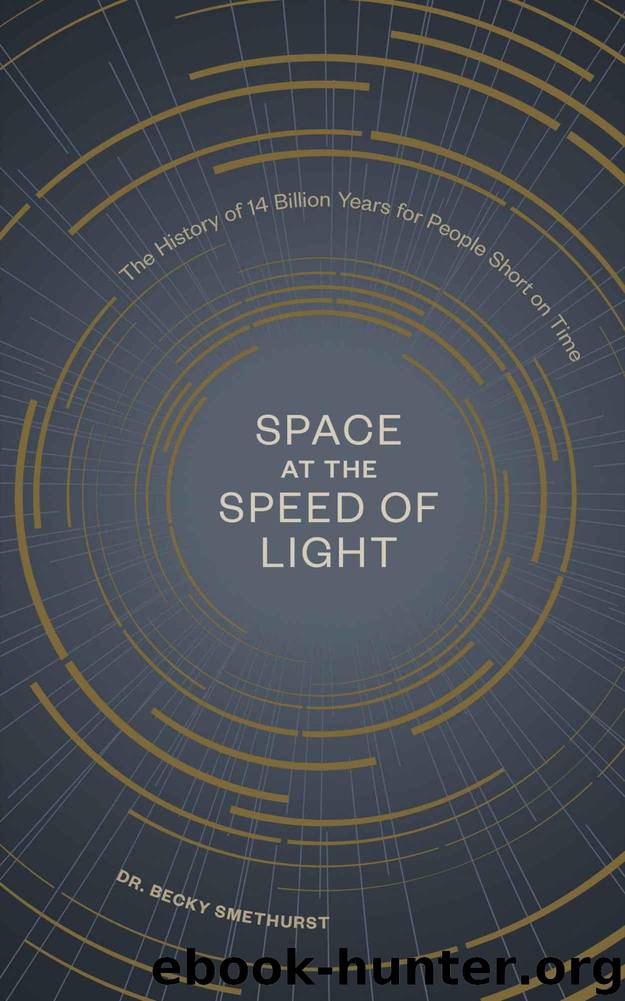Space at the Speed of Light by Smethurst Becky

Author:Smethurst, Becky [Smethurst, Becky]
Language: eng
Format: azw3
Publisher: Potter/Ten Speed/Harmony/Rodale
Published: 2020-06-01T16:00:00+00:00
Back in 1995, radial velocity measurements were used to detect 51 Pegasi b, a roughly Jupiter-size planet orbiting around a Sun-like star every four days. It’s unsurprising that this was the first planet we detected as it’s the Goldilocks of exoplanets: the star is not too massive, the planet is not too small, and its orbit is not too long. All this, combined with the sensitivity of our telescopes back in 1995, meant the conditions to detect 51 Pegasi b were ripe. Its presence causes its star to have a velocity shift of 70 meters (76.5 yards) per second. For comparison, Jupiter causes the Sun to wobble about 13 meters (14 yards) per second, and the Earth only causes a 9-centimeter (3.5 inch)-per-second wobble. That kind of shift is tiny in comparison to the one caused by 51 Pegasi b, a sensitivity our detectors are only reaching now.
By far the most successful method of detecting exoplanets has been using the transit method. This is when a planet passes in front of its star and causes a dip in the star’s observed brightness. Again, if we wait long enough, we may also see this dip in the brightness repeating as the planet passes by the star on each orbit. All we have to do is stare at a patch of sky and continuously record the brightness of all the stars in that patch, then sort through all the data to find the dips in brightness. This is exactly what the Kepler space telescope did from 2009 to 2018. The science team even enlisted the help of the public to find those characteristic dips in brightness that a computer searching through the data might have missed. By doing so, citizen scientists managed to find a seven-planet system around a star, a weird-looking signal that the computer wasn’t programmed to find. Over the years this transit method has been used to find more than 7,500 exoplanets (compare that number with the 456 found from radial velocity measurements and a mere 19 via direct imaging).
A planet passing in front of a star will temporarily reduce the star’s observable brightness.
Download
This site does not store any files on its server. We only index and link to content provided by other sites. Please contact the content providers to delete copyright contents if any and email us, we'll remove relevant links or contents immediately.
| Aeronautics & Astronautics | Astronomy |
| Astrophysics & Space Science | Comets, Meteors & Asteroids |
| Cosmology | Mars |
| Solar System | Star-Gazing |
| Telescopes | UFOs |
Tools of Titans by Timothy Ferriss(8218)
Turbulence by E. J. Noyes(7936)
Secrets of Antigravity Propulsion: Tesla, UFOs, and Classified Aerospace Technology by Ph.D. Paul A. Laviolette(5309)
Astrophysics for People in a Hurry by Neil DeGrasse Tyson(5132)
Room 212 by Kate Stewart(5035)
Design of Trajectory Optimization Approach for Space Maneuver Vehicle Skip Entry Problems by Runqi Chai & Al Savvaris & Antonios Tsourdos & Senchun Chai(5011)
Pale Blue Dot by Carl Sagan(4912)
The David Icke Guide to the Global Conspiracy (and how to end it) by David Icke(4625)
A Journey Through Divination and Astronomy by Publishing Pottermore(4344)
Goodbye Paradise(3727)
Apollo 8 by Jeffrey Kluger(3637)
COSMOS by Carl Sagan(3554)
Losing the Nobel Prize by Brian Keating(3498)
The Five People You Meet in Heaven by Mitch Albom(3475)
How to Read Water: Clues and Patterns from Puddles to the Sea (Natural Navigation) by Tristan Gooley(3406)
Brief Answers to the Big Questions by Stephen Hawking(3369)
How to Read Nature by Tristan Gooley(3249)
The Order of Time by Carlo Rovelli(3145)
A Brief History of Time by Stephen Hawking(2960)
